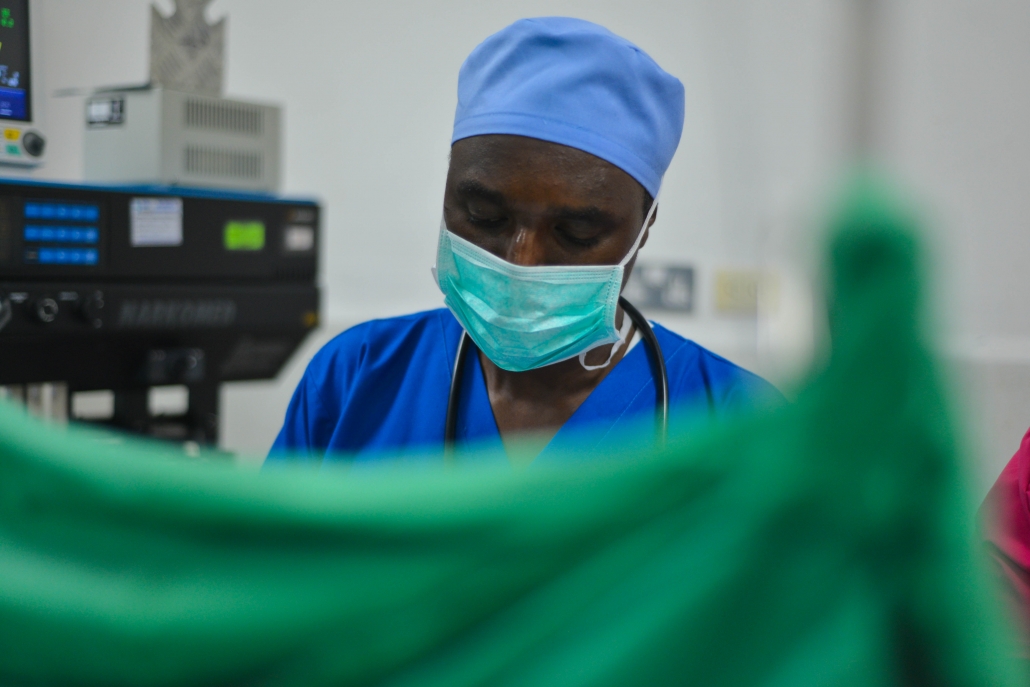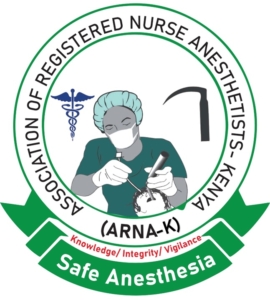WORLD ANESTHETISTS DAY 2020
/2 Comments/in KRNA updates, News, What we do /by KRNAOne of the KRNA chapter responsibilities is to advocate for the welfare of its members. Comprised of license nurse anesthetists and associate student nurse anesthetists member, the KRNA chapter is registered under the National Nurses Association of Kenya. Between April and September 2020, the chapter collected data from its members. A Google form was created and sent to 200 known KRNAs practicing in Kenya. One hundred and ten (55%) of them responded representing 47% of the total number of the KRNAs trained in Kenya. Only 3% of the KRNAs remain unemployed. Among the unemployed are KRNA trainees who while have successfully completed their training, are yet to sit for the licensing exam postponed due to the COVID-19 pandemic.
While more than 70% indicated that they were either neutral or satisfied with their work, a significant percentage expressed dissatisfaction with their remuneration. Some concerns that have been raised that affect job satisfaction include workload, equipment, and supplies. While an ideal situation is to have at least 3 anesthetists per surgical bed to provide 24-hour coverage, many non-physician anesthetists work in under-resourced facilities with only one anesthetist per surgical bed leading to a huge workload. Kenya in general has a limited anesthesia workforce and the situation is more severe outside the capital city of Nairobi, where more than 80% of the anesthesiologists practice. Non-physician anesthetists working independently form the bulk of the anesthesia workforce for the underserved communities in Kenya.
Another major issue is limited equipment; even basic tools like laryngoscopes are not readily available in some facilities and many of the anesthetists are forced to buy their own sets in order to make sure they have one when they need one. Monitoring tools like pulse oximeters are also limited and some facilities have outdated versions of the anesthesia machines that lack standard monitoring like capnography and ECG leads. Supplies of drugs and disposables also remains a challenge. Shortages of pain management drugs like morphine, spinal needles of appropriate sizes and difficult airway equipment including those for pediatrics are a common occurrence.
With regard to remuneration, only 56% of the graduates have been redesignated as nurse anesthetists. This lack of formal recognition of their specialized training locks them out of promotion opportunities. They have also been locked out of fair recruitment process with only a few counties setting aside slots for recruitment of KRNAs when hiring additional anesthesia workforce. The KRNAs have also being locked out of certain allowances including the call allowances despite handing calls in their practice. These challenges have a direct impact on their fair remuneration commensurate to the work done.
Nurse anesthetists are competent and skilled, trained to provide safe anesthesia in all forms of surgery including obstetrics, pediatrics, orthopedic, neurological, plastics, and general surgery. They can administer all forms of anesthesia including general anesthesia with additional skills in pain management, resuscitation and critical care. The KRNA chapter has strived to ensure that their members have members to not only CME opportunities but also create forums for engagement and mentorship as well as explore options for higher level of training. As we celebrate the World Anesthesia Day, we look forward to a future where the role nurse anesthetists play in the delivery of safe anesthesia will be recognized. Our work in bridging the gaps in access to safe surgery is unquestionable and the chapter will continue to advocate for its members to ensure they are well compensated, well trained, and perform their work to the highest possible standard
Investing in anesthesia workforce: a case for non-physician anesthetists
/in Continuing Medical Education, KRNA updates, News, Uncategorized /by KRNA
Five billion people lack access to safe surgical and anesthesia services. In some parts of the world, this translates to more than 95% of the population without access to safe surgery. Surgery is described as the neglected step-child of Global Health. In the same breath, anesthesia is surgery’s ‘invisible sister’.
EIGHTH ANNUAL KRNA CONFERENCE: NYERI COUNTY EDITION
/in Continuing Medical Education, News /by KRNAThe focus of the 8th Annual KRNA conference was on the Principles and Perspectives on Pediatric Anesthesia and Pain Management. This event provides anesthesia providers and primarily, the Kenya Registered Nurse Anesthetists (KRNA), with an opportunity for a rich Continuous Medical Education experience. With a mix of both local and international faculty, the KRNA conference has provides a mix of both classroom and practical learning. Since 2014, simulation based training has been a part of the KRNA conference experience. This year, the simulation based training focus was on managing pediatric emergencies and neonatal resuscitation.
Simulation training is becoming an important part of healthcare training. It is of great importance and in future, I hope we can use simulation training to further to strengthen quality anesthesia care on our continent
Steve Thuo, Simulation Training Facilitator, Kijabe Hospital
Introduced this year were panel sessions that gave the delegates an opportunity to share real time experience on certain topics including management of pediatric syndromes and airway management for pediatrics. The delegates also had an opportunity to listen to a rich mix of lectures on various topics ranging from fluid management, airway management, protecting brain development and multimodal perioperative pain management among others. The delegates also had the chance to present cases that created a forum for problem based learning discussion.
This year’s event was made possible through funding from our partners that included Africa Mission Healthcare and Abbvie. The support they provide allow the planning committee subsidize the cost of the conference. This year’s event was attended by almost 100 anesthesia providers from across Kenya, South Sudan, Ethiopia, and Tanzania. Our key speakers came from various institutions including Kijabe Hospital, Vanderbilt Children’s Hospital, Children’s Hospital of Philadelphia, and University of Nairobi. We thank all the individuals and institutions that made this conference a success and look forward to continued partnership as we seek to ensure safe (and pain free) surgery and anesthesia for all.

LAUNCH OF THE OFFICIAL KRNA SCOPE OF PRACTICE
/in KRNA updates, News /by GatwiriIt has been three years in the making. The journey to develop a Scope of Practice for the Kenya Registered Nurse Anesthetists started during a meeting among a small group of practicing KRNAs. This document was something that every KRNA wanted to have so that the primary employer, the Government of Kenya, could formally adopt this cadre of practitioners into the health structure. The journey to have nurse anesthesia practice in Kenya started in the early 2000s. Some nurses left the country for certificate training programs available across our borders in countries like Tanzania. Others served as theatre nurses and were trained on the job to give anesthesia. At Kijabe, the sole anesthesiologist at the time-Dr. Mark Newton-started training his theatre nurses to give anesthesia. Having come from the US where a mix of physician and nurse anesthesia providers is standard practice in some setting, he knew that there was potential for this practice to be replicated here. Since formal accreditation in 2006, the numbers have grown to more than 200 practicing and student KRNAs
Caption from speech prepared by chief guest
In Kenya, we face a huge gap in the number of anesthesia providers. This is one of the reasons non-physician anesthesia providers (NPAPs)-the clinical officers and nurses cadres- were approved and accredited. We still have a long way to go in terms of numbers. Such documents are a testament to the need to hold healthcare professionals to standards that will ensure patient safety above all.
On 14th June the 1st Edition of the Scope of practice was formally launched during the 8th Annual KRNA conference held in Nyeri County. The document further cements the role of nurse anesthetists as a vital part of provision of safe anesthesia. Invited Guests representing various organizations including National and County Government, Nursing Council of Kenya, various nursing bodies including the NNAK, NACOA, and representatives of Center for Public Health and Development, joined us for the launch. These guests represent institutions that have supported the development of the KRNA Scope of Practice
Ms. Priscilla Emojong, Head of Nursing Education, Training and Research, Office of Director of Nursing, MoH
This document that we are here to launch today is meant to serve as a guide to define who a nurse anesthetist is and what role they play in our health system. Anesthesia care is a critical need in a health system. It is said that there can be no surgery without anesthesia. I know that the under-served communities in rural Kenya, especially pregnant mothers, are grateful for the services you provide.
The KRNA Chapter appreciates all members, partners, donors, employers and colleagues who have supported us to ensure that this document becomes a reality.
With support from partners like ImPACT Africa and Center for Public Health and Development, the idea of an official Government document recognizing KRNAs has become a reality. This scope of practice will form the foundation for the development of a scheme of service that will allow the Human Resource system in both Government and private employers recruit and retain nurse anesthetists.
Samson Miriti, KRNA Chapter Chairman, 2017-To date
KRNA
Kenya Registered Nurse Anesthetists
KRNA Calendar
| M | T | W | T | F | S | S |
|---|---|---|---|---|---|---|
| 1 | 2 | 3 | 4 | |||
| 5 | 6 | 7 | 8 | 9 | 10 | 11 |
| 12 | 13 | 14 | 15 | 16 | 17 | 18 |
| 19 | 20 | 21 | 22 | 23 | 24 | 25 |
| 26 | 27 | 28 | 29 | 30 | 31 | |
